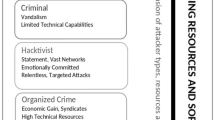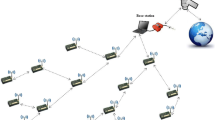Abstract
In this paper, we investigate the interactions between the intrusion prevention systems (IPSs) and attackers in wireless networks. We model this interactions as a non-cooperative differential game. In terms of model construction, each node is allowed to choose its optimal cost of resource consumption to contribute to the security problem depending on the state. We derive the optimal strategies for the attackers and the IPSs over time, respectively. Simulation analysis will be given to illustrate that the dynamic evolution of the defense strategy of the IPSs and the trajectory of the attackers based on the proposed scheme.



Similar content being viewed by others
References
Chowdhury, A. (2016). Recent cyber security attacks and their mitigation approaches – An Overview. In L. Batten & G. Li (Eds.), Applications and techniques in information security. Communications in computer and information science (Vol. 651, pp. 54–65). Singapore: Springer.
Wei, J., Zhang, R., Liu, J., et al. (2015). Defense strategy of network security based on dynamic classification. Ksii Transactions on Internet & Information Systems, 9(12), 5116–5134.
Butun, I., Morgera, S. D., & Sankar, R. (2014). A survey of intrusion detection systems in wireless sensor networks. IEEE Communications Surveys & Tutorials, 16(1), 266–282.
Yi, P., Zhu, T., Ma, J., et al. (2013). An intrusion prevention mechanism in mobile ad hoc networks. Ad Hoc & Sensor Wireless Networks, 17(3), 269–292.
Butun, I., Wang, Y., Lee, Y., et al. (2012). Intrusion prevention with two-level user authentication in heterogeneous wireless sensor networks. International Journal of Security and Networks, 7(2), 107–121.
Das, M. L. (2009). Two-factor user authentication in wireless sensor networks. IEEE Transactions on Wireless Communications, 8(3), 1086–1090.
Demirkol, I., Alagoz, F., Deliç, H., et al. (2006). Wireless sensor networks for intrusion detection: Packet traffic modeling. IEEE Communications Letters, 10(1), 22–24.
Fuchsberger, A. (2005). Intrusion detection systems and intrusion prevention systems. Information Security Technical Report, 10(3), 134–139.
Rodas, O., To, M. A., Alvarez, J., et al. (2015). Protecting wireless mesh networks through a distributed intrusion prevention framework. In 2015 7th IEEE Latin-American conference on communications (LATINCOM) (pp. 1–6). IEEE.
Das, M. L. (2009). Two-factor user authentication in wireless sensor networks. IEEE Transactions on Wireless Communications, 8(3), 1086–1090.
Alpcan, T., & Baar, T. (2010). Network security: A decision and game-theoretic approach. Cambridge: Cambridge University Press.
Agah, A., Das, S. K., Basu, K., et al. (2004). Intrusion detection in sensor networks: A non-cooperative game approach. In Network computing and applications.
Bedi, H. S., Roy, S., & Shiva, S. (2011). Game theory-based defense mechanisms against DDoS attacks on TCP/TCP-friendly flows. In 2011 IEEE symposium on computational intelligence in cyber security (CICS) (pp. 129–136). IEEE.
Li, F., Yang, Y., & Wu, J. (2010). Attack and flee: Game-theory-based analysis on interactions among nodes in MANETs. IEEE Transactions on Systems, Man, and Cybernetics, Part B (Cybernetics), 40(3), 612–622.
Yeung, D. W. K., & Petrosjan, L. A. (2006). Cooperative stochastic differential games. Berlin: Springer.
Author information
Authors and Affiliations
Corresponding author
Additional information
Publisher's Note
Springer Nature remains neutral with regard to jurisdictional claims in published maps and institutional affiliations.
Rights and permissions
About this article
Cite this article
Miao, L., Li, S. A Differential Game-Theoretic Approach for the Intrusion Prevention Systems and Attackers in Wireless Networks. Wireless Pers Commun 103, 1993–2003 (2018). https://doi.org/10.1007/s11277-018-5892-1
Published:
Issue Date:
DOI: https://doi.org/10.1007/s11277-018-5892-1




